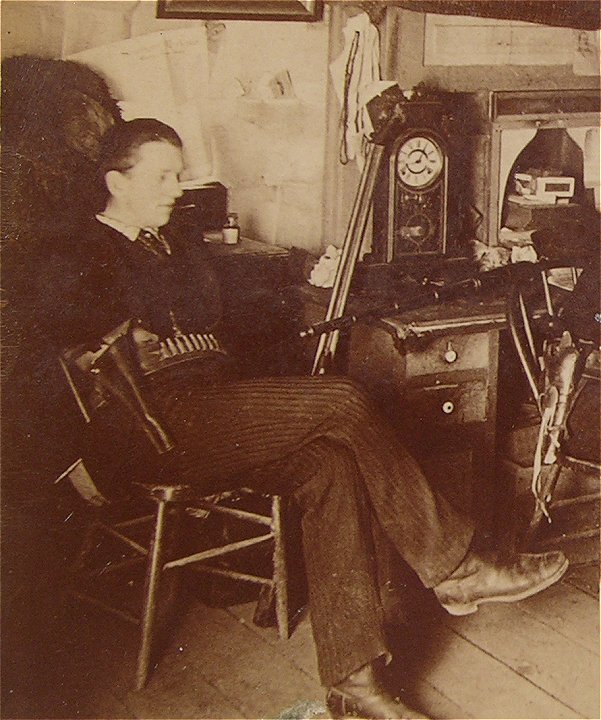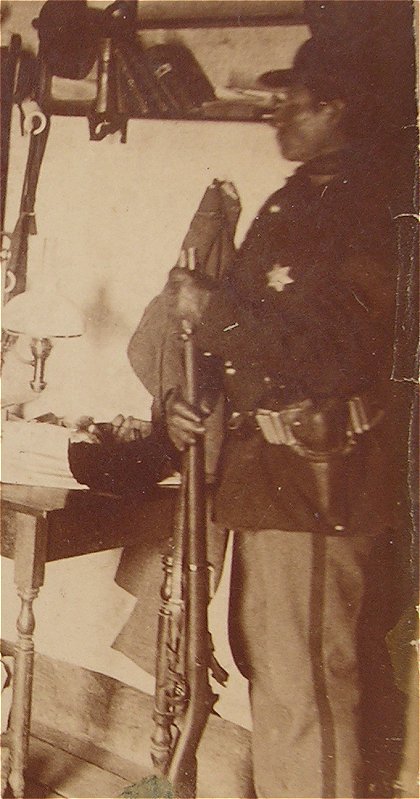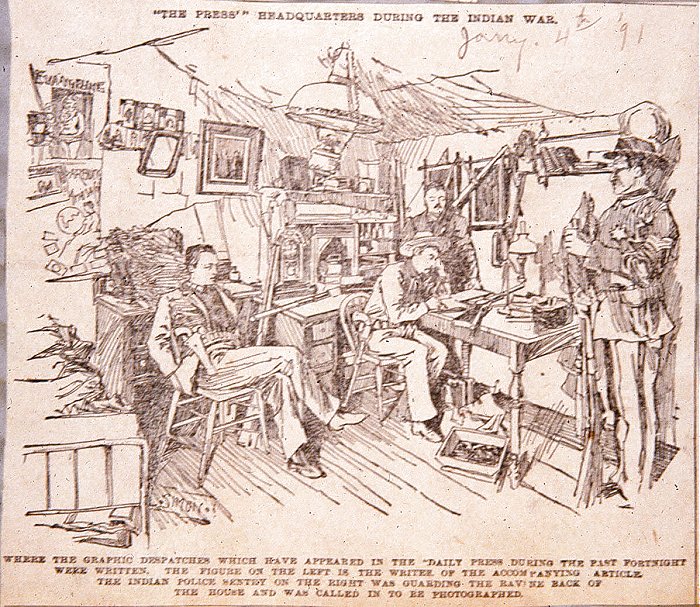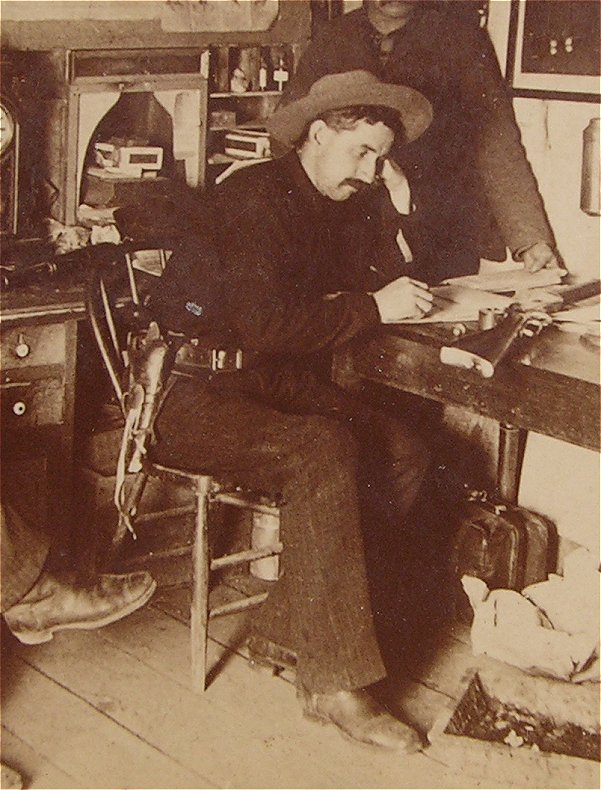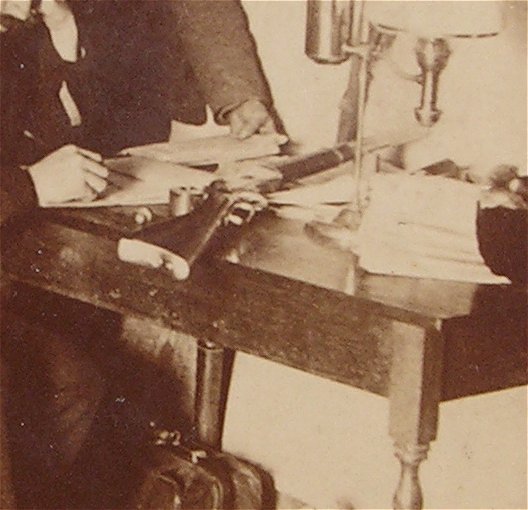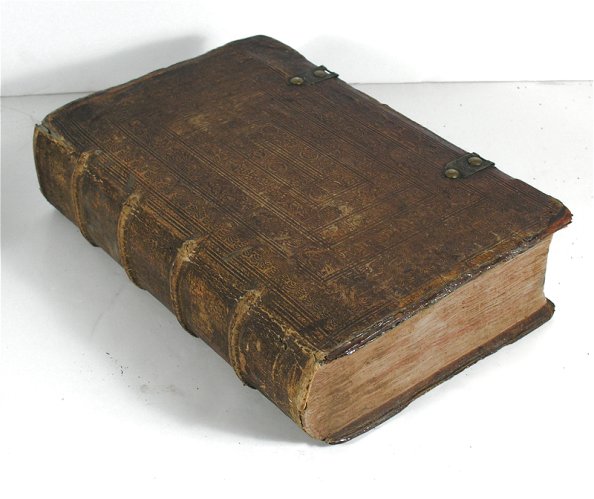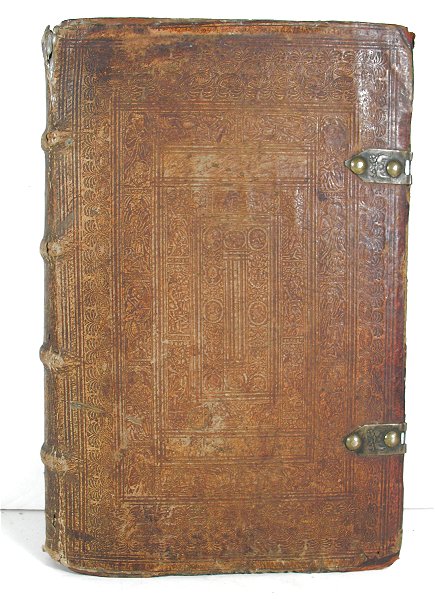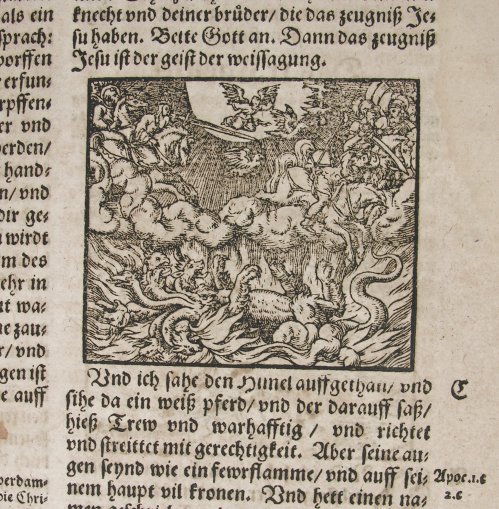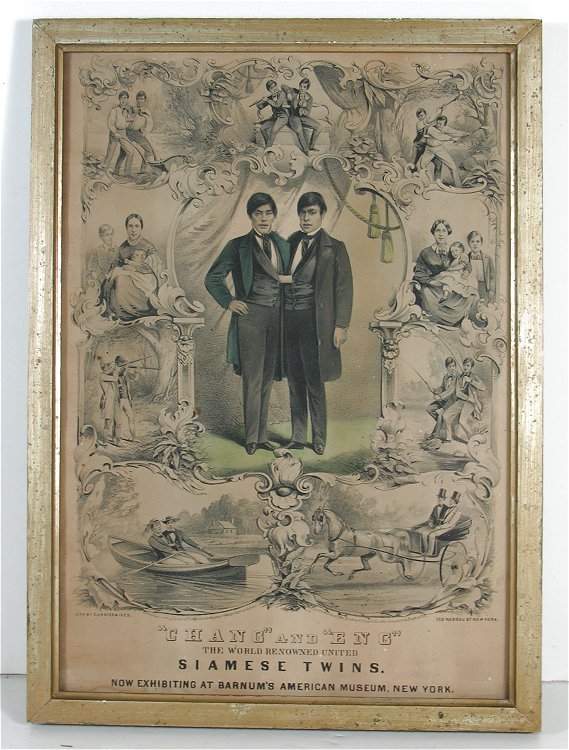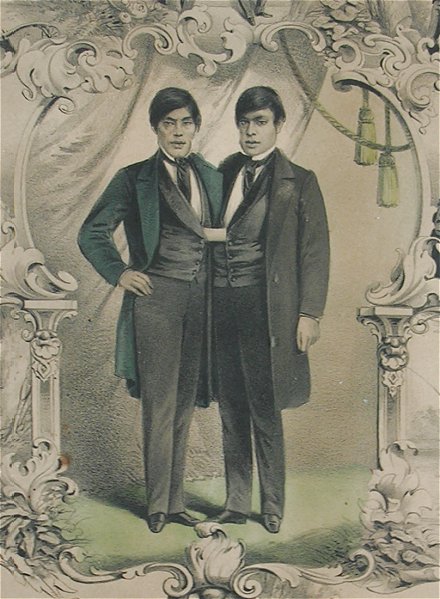Wounded Knee Indian Massacre: Rare View Of The “Press Headquarters”
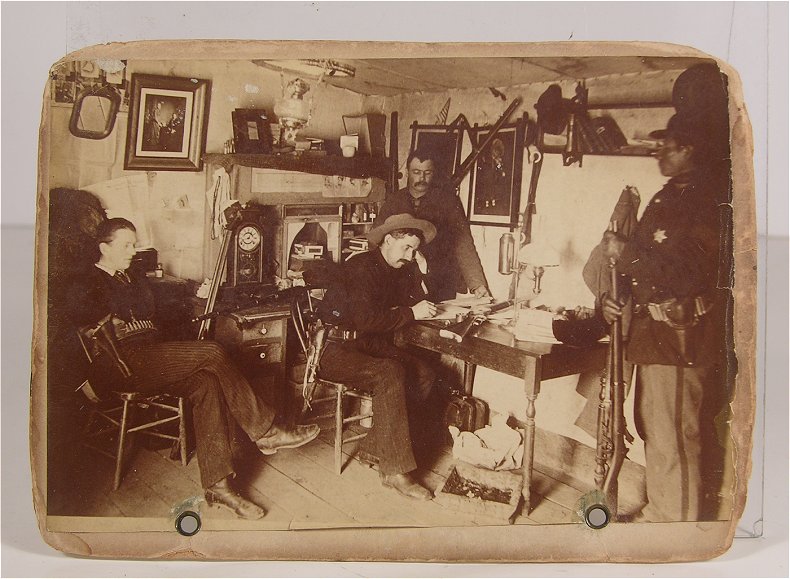 This is a truly amazing January 1891, Albumen Cabinet Card Photograph of a small log cabin behind the Post Office at the Pine Ridge Agency in South Dakota – the location from which the first news reports about the Wounded Knee Massacre were written. In this photo we see U.S. Marshall George Bartlett, writer / archeologist / anthropologist Warren King Moorhead, an Indian Police sentry in full uniform and a third, unidentified white man believed to be Louis Mousseau who lived in the cabin and ran the Post Office / Store. The Photograph was likely taken by George Trager (or one of the photographers working with him) and a drawing taken from this Photograph was published in an early January 1891 edition of the American Illustrated Weekly Newspaper. We can find absolutely no information about this photograph other than the caption in the Illustrated Newspaper – we believe that this may be the only know example of this important image.
This is a truly amazing January 1891, Albumen Cabinet Card Photograph of a small log cabin behind the Post Office at the Pine Ridge Agency in South Dakota – the location from which the first news reports about the Wounded Knee Massacre were written. In this photo we see U.S. Marshall George Bartlett, writer / archeologist / anthropologist Warren King Moorhead, an Indian Police sentry in full uniform and a third, unidentified white man believed to be Louis Mousseau who lived in the cabin and ran the Post Office / Store. The Photograph was likely taken by George Trager (or one of the photographers working with him) and a drawing taken from this Photograph was published in an early January 1891 edition of the American Illustrated Weekly Newspaper. We can find absolutely no information about this photograph other than the caption in the Illustrated Newspaper – we believe that this may be the only know example of this important image.
This Photograph has absolutely no identification, nor a photographer’s mark but our extensive online research turned up the fascinating story of this wonderful image. As far as the photographer is concerned, we know that Warren King Morehead (pictured at the left) was the only news reporter on site in the days following Wounded Knee that had “his own photographer”. There is some confusion in many of the pictures associated with Morehead, because on top of having “his own photographer”, he also in many instances took photos himself. In this particular case it appears most likely that Morehead engaged one of the few photographers who were present at Pine Ridge in the days following the “Battle”, all of whom were employed by George Trager.
The Photo is a truly amazing tableaux with Warren King Moorehead seated wearing a revolver in a holster attached to a belt loaded with cartridges. A large caliber, double barreled shotgun leans against a clock behind Mooreheads chair. Pine Ridge and Deadwood, South Dakota Deputy U. S. Marshall George Bartlett sits at a table writing furiously. Bartlett also has a substantial six gun in a holster at his belt and a beautiful, Winchester Repeating rifle on the table in front of him. The Indian Police Sentry also wears a revolver in a holster on rig studded with cartridges and holds his Springfield rifle in front of him. This room is cluttered but certainly chock full of weapons with a large caliber rifle leaning against the wall behind the unidentified gentleman and another rifle on the desk to the right of Moorehead.
We were able to identify the folks in this Photograph from the caption printed under the Newspaper illustration taken directly from the Image. The caption reads: “Where the graphic dispatches which have appeared in the daily press during the past fortnight where written. The figure on the left is the writer of the accompanying article. The Indian police sentry on the right was guarding the ravine back of the house and was called in to be photographed”. The accompanying article was written by Moorehead (thus identifying him in the photo) and we could easily identify Bartlett (from other portraits) who was Moorehead’s friend and Indian language translator. The location was somewhat of a mystery until we discovered a photograph published on page 124 of the volume titled “Eyewitness at Wounded Knee” (Jensen, Paul and Carter; Nebraska State Historical Society, 1991). That image shows Marshall George Bartlett standing in front of the combination Post Office and Store owned by Louis Mousseau with its small attached log cabin residence. The caption led us to believe that the Image offered here was taken in the residence of Mousseau. That caption reads “The first news stories of the killings at Wounded Knee were written in the small log cabin shown here, just behind the Wounded Knee Post Office… The small cabin was the home of Louis Mousseau, a French-mixed blood, who operated the combination Post Office and store. This was the nucleus of a small community. There was a day school, a little used Presbyterian church and a nearby dance lodge. George Bartlett (standing) had a financial interest in the store.”. The caption to this photograph seems to identify the location of the Photo offered here (by its reference to the earliest reports of Wounded Knee and the connection with George Bartlett) but also likely identifies the unknown white man in the image as the owner of the home – Louis Mousseau.
George E. Bartlett was a quite fascinating character – a U.S. Marshal for Pine Ridge Agency as well as for a city west of there already infamous as Deadwood, South Dakota. Bartlett had worked as a sales representative for the gunpowder company and also ran a small trading post of his own on a creek through part of the Pine Ridge Reservation. From his wild days as a Pony Express rider and then Marshal in Deadwood, Bartlett had picked up the Indian name “Huste,” which was explained to be a dialect word for “Wounded Knee”. Bartlett had been sent to Pine Ridge in hopes that he could negotiate an end to the “Ghost Dance Troubles”.
In early 1890 Bartlett had invited a young writer / archeologist / anthropologist by the name of Warren King Moorhead out to visit him and had taken him around to the camps and settlements of the Lakota Sioux across the Nebraska/South Dakota border. After the relative success of the author’s novel “Wanneta” (which included much material gathered in this earlier visit) Bartlett had continued to suggest Moorehead come out again to write about this Ghost Dance phenomenon. With the support of an editor at “The Illustrated American”, Moorehead traveled to Chadron, Nebraska where Bartlett owned a ranch, and quickly found himself welcomed in the camp of Red Cloud, a greatly respected Lakota leader.
Moorehead never claimed to speak any of the Lakota dialects he encountered, but the articles he later wrote included a variety of Indian words, and of course his friend and guide George Bartlett spoke a number of Sioux tongues quite well. During this time Moorhead took some of the only photographs of the Ghost Dance ceremony seen before the Wounded Knee Massacre. After almost eight weeks of travel and camping among the various settlements across the Pine Ridge area, he was called into the headquarters of Gen. John R. Brooke, commanding officer of the Department of the Platte. According to Moorehead’s journal, Brooke informed him that as he was the only correspondent who spoke the “hostiles” language, and was accepted enough to overnight in their camps, he was considered a liability to the Army as they tried to bring order to the Pine Ridge situation: so two soldiers would escort him directly to his quarters, watch him pack, and take him to the next train east. Bartlett, however, remained behind and is seen in various photographs taken by Trager and W. R. Cross in the days following the Wounded Knee Massacre. Moorhead returned to Pine Ridge just after New Years Day 1891 and began reporting on the aftermath of the massacre. George Trager and his Northwestern Photographic Company photographers are best known for the Photographs taken in the days leading up to the Battle of Wounded Knee and for those taken of the aftermath of that bloody massacre.
For more information, please see our eBay listing.
FollowIn Nomine Patris: A 1590 Illustrated Edition of the “Dietenberger” Bible
Pictured here is an exceptionally rare and fantastic, original 1590 edition of the illustrated German-language “Dietenberger Bible,” one of three Catholic Counter-Reformation bibles, and the first of the German translations. This fantastic, 16th-century bible is complete and intact, bound in its original pigskin with elaborate, blind-stamped images of the saints. It was recently acquired from the library archives of a New York State monastery where it has resided for 100+ years, and from which it was recently obtained along with a number of other fantastic, 16th through 18th century volumes, which we will be offering on our eBay page over the next few weeks.
The bible offered here is titled “Bibell. Das ist, Alle Bücher Alts und News Testaments, nach Alter in Christlicher Kyrchen gehabter Translation trewlich verteutscht, und mit vielen heilsamen Annotaten erleucht, Durch D. Johann Dietenberger. Jetzt an vielen orten corrigiert, und gebessert, mit schönen kunstreichen figuren geziert, und fleissiger dann je vorhin außgangen.” (Commonly referred to as the “Dietenberger Bible,” translated by Johann Dietenberger. Published at Cologne by Arnold Quentel, 1790. It contains 1200 pages, including 139 woodcuts, 99 multi-line and many small initials, and 2 woodcut vignettes.
The so-called “Dietenberger Bible” is one of three Catholic Counter-Reformation bibles that can be understood as a response to the then-emerging New International Version. The German translation by Johann Dietenberger of the Old and New Testament was the first fully Catholic Bible of the Reformation period. From its first appearance in 1534 through the 18th Century, at least 58 editions were published (see BBKL, 1, 1296). John Dietenberger (c. 1475-1537) was a Dominican Order prior and later professor of theology in Mainz (see NDB 3, 667 et seq.). In 1534, the first edition of his translation of the bible was published. Dietenberger added comments on the chapters of the Old Testament and gave it summary headings. The present bible comes from the highly-regarded printing house Quentel in Cologne (see ADB 27, 37 ff.).
Johann Dietenberger (c. 1475 – September 4, 1537) was a German Catholic scholastic theologian. Born at Frankfurt-am-Main, he was educated in his native city, and joined the Dominican Order. On June 3, 1511, he registered at Cologne as a theological student. Three years later, on September 23, 1514, he was admitted to the licentiate, and the next year, after some time spent at Heidelberg and Mainz, he received the doctor’s degree. Towards the end of 1517, Dietenberger was appointed Regens studiorum and interpreter of Thomas Aquinas at Trier, where he opened his lectures on January 27, 1518. In the meantime, he had been elected (1516) prior of his convent at Frankfurt, and retained this office until 1526, when he became prior at Koblenz. In 1530, Dietenberger attended the Diet of Augsburg and was chosen as a member of the committee of twenty Catholic theologians selected at the meeting of June 27th, and presided over by Johann Eck, to draw up a refutation of the Protestant Confession. At about the same time, he received the appointment of general inquisitor for the Dioceses of Mainz and Cologne. His last years, from 1532, were devoted to teaching theology and exegesis in the Academy of Mainz.
In preparing the “Dietenberger Bible” the author used freely the New Testament of Emser (1527), of whom Martin Luther was wont to say that “he had ploughed with his heifers;” he used likewise other translations compiled in pre-Reformation times, and so did Luther. He was well acquainted with the versions of Luther and of Leo Jud, and used them to improve his own.
For more information, please see our eBay listing.
FollowFascinations: P.T. Barnum Commissioned Currier & Ives Lithograph of “Siamese Twins” Chang and Eng Bunker
Picture above is a very rare and wonderful, 1860 Currier & Ives stone lithograph advertising print for P. T. Barnum’s American Museum. The print features Barnum’s Premier Sideshow / Circus Freaks / Human Oddities Exhibit “Chang and Eng,” the original “Siamese Twins.”
The piece measures 9 ¾” by 13 7/8″ (including visible margins on all sides) and is framed for display in a simple, period, gold gilt surface wooden frame (overall size of framed display is 11 7/8″ by 14 7/8″). The image features a central, full-figured portrait of the conjoined twins surrounded by smaller, vignette images of scenes depicting the Twins in various daily activities. Included are views of Chang and Eng plowing a field, playing musical instruments, chopping down a tree, hunting, fishing, rowing a boat and driving a carriage. Also included are portraits of each man’s wife with their young children.
The text below the images reads “’Chang’ and ‘Eng’ / The World Renowned United Siamese Twins. / Now Exhibiting At Barnum’s American Museum, New York.” The lithograph is copyright 1860 by the publishers and lithographers, Currier & Ives.
Born in Siam (now Thailand) in 1811, Eng and Chang Bunker were connected at the chest by a five-inch-wide band of flesh. The location of this connection suggested to some doctors and other observers that the brothers shared a heart or some respiratory functions. These medical assumptions would later be proven wrong. In fact, it is believed that the brothers were xiphopagus twins, meaning they were joined only by a small piece of cartilage located at the sternum. The only organs fused were their livers, but each twin had a complete liver that could function independently. By careful practice, they were able to stretch their connective tissue enough for that they could stand side-by-side, rather than facing each other. This is what gave the “iconic” Siamese Twin look, where perception leads us to believe they are joined at the side, and which is the common depiction of this affliction. It is believed that separating Chang and Eng would have been very easy, even for the medical technology available at the time.
According to their biography, the twins shared relatively “normal” boyhoods in Siam, running and playing with other children, doing chores, and helping to support their parents and siblings by gathering and selling duck eggs in their small village. Later, as teenagers, the twins left Siam and began a career traveling with two agents, Robert Hunter and Abel Coffin.
Eng and Chang earned money by giving lectures and demonstrations throughout the United States, Canada, South America, and Europe. In fact, entries in their travel-expense journal document that they visited the campus of the University of North Carolina at Chapel Hill in October, 1834. In their far-flung travels, Eng and Chang became such popular celebrities during the 1830′s that their promotion as “Siamese twins” were terms that were universally employed to describe connected or conjoined twins.
By the late 1830′s, Eng and Chang grew tired of all their traveling, opting then to settle in North Carolina. There, the brothers married two sisters, Adelaide and Sarah Yates of Wilkes County. The sisters were of European ancestry and were neither twins nor connected themselves. The couples were married in 1843, and would ultimately produce 21 children between the two families.
Although they had minimal dealings with P. T. Barnum, the master showman displayed a wax figure of the twins in the American Museum in the 1840s, published a pamphlet on their lives in 1853, and publicly associated himself with the brothers. With large families to support, Chang and Eng returned to show business in 1860, agreeing to a six-week engagement at Barnum’s American Museum. This lithograph was issued to promote that appearance and was likely commissioned of Currier & Ives by P.T. Barnum himself. After suffering financial loses during the Civil War, the brothers again agreed to a European tour sponsored by Barnum in 1868, but these were the only times that they were in any way associated with P.T. Barnum.
Eng and Chang died in January 1874, at the age of 63. Chang preceded Eng in death by about two and a half hours. An autopsy indicated that Chang died of a blood clot in the brain; and, at the time, Eng’s demise was attributed, understandably, to shock.
Follow
Walnutts FAQ’s: Hey, Can I Get A Copy Of That?
Q. I was looking through your auction items and found one that really interested me! However, it was way out of my price range/already sold by the time I was ready to bid. Now that the auction is over, I was just wondering if I could get a copy of that manuscript/map/photo you posted? Could you do that?
A. We have a policy of not supplying copies of photographs or manuscript material that we are selling at auction. We feel that it is only fair to reserve the publication and distribution rights for the high bidder, as often it is of significant value to them. We will gladly pass along your request to the purchaser, and (as has happened in many cases) it is likely that he or she will oblige your request- we do feel, however, that that decision is up to the new owner.
Follow
